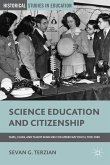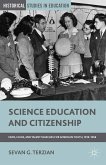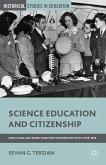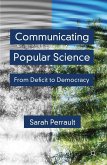Handbook for Small Science Centers
Herausgeber: Yao, Cynthia C; Wolf, Sarah; Schatz, Dennis; Anderson, Peter A; Dierking, Lynn D
Handbook for Small Science Centers
Herausgeber: Yao, Cynthia C; Wolf, Sarah; Schatz, Dennis; Anderson, Peter A; Dierking, Lynn D
- Gebundenes Buch
- Merkliste
- Auf die Merkliste
- Bewerten Bewerten
- Teilen
- Produkt teilen
- Produkterinnerung
- Produkterinnerung
Comprehensive handbook for starting and running a small science center.
Andere Kunden interessierten sich auch für
![Science Education and Citizenship Science Education and Citizenship]() S. TerzianScience Education and Citizenship41,99 €
S. TerzianScience Education and Citizenship41,99 €![Science Education and Citizenship Science Education and Citizenship]() S. TerzianScience Education and Citizenship41,99 €
S. TerzianScience Education and Citizenship41,99 €![Narratives of Doctoral Studies in Science Education Narratives of Doctoral Studies in Science Education]() Narratives of Doctoral Studies in Science Education140,99 €
Narratives of Doctoral Studies in Science Education140,99 €![Communicating Popular Science Communicating Popular Science]() S. PerraultCommunicating Popular Science81,99 €
S. PerraultCommunicating Popular Science81,99 €![Science Education and Citizenship Science Education and Citizenship]() S. TerzianScience Education and Citizenship41,99 €
S. TerzianScience Education and Citizenship41,99 €![Communicating Popular Science Communicating Popular Science]() S. PerraultCommunicating Popular Science89,99 €
S. PerraultCommunicating Popular Science89,99 €![Reconceptualizing Stem Education Reconceptualizing Stem Education]() Reconceptualizing Stem Education143,99 €
Reconceptualizing Stem Education143,99 €-
-
-
Comprehensive handbook for starting and running a small science center.
Hinweis: Dieser Artikel kann nur an eine deutsche Lieferadresse ausgeliefert werden.
Hinweis: Dieser Artikel kann nur an eine deutsche Lieferadresse ausgeliefert werden.
Produktdetails
- Produktdetails
- Verlag: Altamira Press
- Seitenzahl: 328
- Erscheinungstermin: 1. Juni 2006
- Englisch
- Abmessung: 292mm x 216mm x 25mm
- Gewicht: 1588g
- ISBN-13: 9780759106529
- ISBN-10: 0759106525
- Artikelnr.: 21113052
- Herstellerkennzeichnung
- Libri GmbH
- Europaallee 1
- 36244 Bad Hersfeld
- gpsr@libri.de
- Verlag: Altamira Press
- Seitenzahl: 328
- Erscheinungstermin: 1. Juni 2006
- Englisch
- Abmessung: 292mm x 216mm x 25mm
- Gewicht: 1588g
- ISBN-13: 9780759106529
- ISBN-10: 0759106525
- Artikelnr.: 21113052
- Herstellerkennzeichnung
- Libri GmbH
- Europaallee 1
- 36244 Bad Hersfeld
- gpsr@libri.de
Edited by Cynthia C. Yao; Lynn D. Dierking; Peter A. Anderson; Dennis Schatz and Sarah Wolf - Contributions by Pat Adams; American Association of Museums; Association of Science-Technology Centers; Elsa B. Bailey; Mary Baske; Bronwyn Bevan; Colleen Blair;
Chapter 1 Foreword Chapter 2 Preface and Acknowledgments Part 3 I. Central
Case Study Chapter 4 1. The Ann Arbor Hands-On Museum: From Dream to
Reality Part 5 II. Case Studies of Other Small Science Centers and
Start-Ups Chapter 6 2. Developing in Phases:A Case History Chapter 7 3.
Hockey, Nickel Mines, and the Pursuit of a Vision: Getting it Done at
Science North Chapter 8 4. Once Small Center's Story: Grass Roots Thrive on
Flexibility Chapter 9 5. Focus and Balance for the Small Museum Chapter 10
6. Discovery Center Start-Up: Launch Pad in a Mall Chapter 11 7. Curious
Kids' Museum Chapter 12 8. Science Spectrum: A Science Center for the South
Plains of Texas Chapter 13 9. Science Center in a College: An Unabashadly
Autobiographical Account Chapter 14 10. Science Projects: The Observatory
Science Centre, Herstmonceux and Inspire Discovery Centre, Norwich Chapter
15 11. Experimentarium: A Fairy Tale from Hans Christian Andersen's Denmark
Part 16 III. Getting Started and Running a Science Center Chapter 17 12.
Planning the Building Chapter 18 13. Sci-Port Discovery Center: How We
Operate and Position Our Science Center for Ongoing Success Chapter 19 14.
Over the Top: Building Resources to Open and Grow Chapter 20 15. Marketing
Basics: Applications for Small Science Centers Chapter 21 16. The Science
Shop at Science Spectrum Part 22 IV. Exhibits Chapter 23 17. Decision
Making on Purpose: Translating Organizational Identity into Effective
Experiences Chapter 24 18. Making Effective Exhibits for Rewarding Visitor
Experiences Chapter 25 19. Learning from My Mistakes Chapter 26 20. The Use
of Objects in a Small Science Center Part 27 V. Creating Special Exhibits
Spaces Chapter 28 21. Discovery Spaces: Small Museums within a Large Museum
Chapter 29 22. Creating Developmentally Appropriate Early Childhood Spaces
in Science Centers Chapter 30 23. Outdoor Science Parks: Going Beyond the
Walls Chapter 31 24. Traveling Exhibitions: Rationales and Strategies for
the Small Museums Part 32 VI. Education Programs Chapter 33 25. Developing
an Educational Plan Chapter 34 26. Building Capacity to Work with Schools
Chapter 35 27. The Why and How of Doing Outreach Programming: Fulfilling My
Fantasy Chapter 36 28. Fifty Years of Museum School Chapter 37 29.
Promoting Public Understanding of Research through Family Science Programs
at MIT Part 38 VII. Working in a Science Center Chapter 39 30. Leading and
Implementing Innovation in Your Science Museum Chapter 40 31. Hiring,
Supporting, and Developing Museum Educators for Your Science Center Chapter
41 32. Explainers: Youth Development at the Exploratorium Part 42 VIII.
Audience Chapter 43 33. Understanding Your Audience Chapter 44 34. Girls,
Boys, Moms, and Dads: Learning about Their Different Needs in Science
Museums Chapter 45 35. Evaluation 101 Part 46 IX. Governance Chapter 47 36.
Working Model: A Mechanism for the Effective Board Chapter 48 37. Code of
Ethics for Museums Part 49 X. Transitions Chapter 50 38. Building a
Sustainable Future Chapter 51 39. Renovation as Innovation: SciWorks, the
Science Center and Environmental Park of Forsyth County Chapter 52 40.
Collaborations: From Sharing a Museum Site to Winning NSF Grants Chapter 53
41. Exploration Place: Science Center and Children's Museum Combined
Chapter 54 42. From Little Acorns Chapter 55 43. The Tech: The Challenges
of Growing from Small to Large Chapter 56 44. How to Foster Innovation
within Your Science-Technology Center: Observations from Under the Seat
Cushion Part 57 XI. Overview of Science Centers Chapter 58 45. Science
Center History Chapter 59 46. Fanning the Flames: The Exploratorium at the
Birth of the Science Center Movement Chapter 60 47. SESAME Program: The
Impact of a PhD Program on Science Museums Chapter 61 48. Science and
Discovery Centers: The European Perspective Part 62 XII. Science Centers
and the Future Chapter 63 49. Developing a New Business Model for Science
Centers Chapter 64 50. Reality, Variety, and Ingenuity: Futures for Science
Centers Part 65 XIII. Resources Chapter 66 Appendix A. Resources for
Exhibit Fabrication Chapter 67 Appendix B. ASTC and Related Organizations
Chapter 68 Appendix C. Directory of Science Centers, Institutions, and
Individuals Represented Chapter 69 Index Chapter 70 About the Authors
Case Study Chapter 4 1. The Ann Arbor Hands-On Museum: From Dream to
Reality Part 5 II. Case Studies of Other Small Science Centers and
Start-Ups Chapter 6 2. Developing in Phases:A Case History Chapter 7 3.
Hockey, Nickel Mines, and the Pursuit of a Vision: Getting it Done at
Science North Chapter 8 4. Once Small Center's Story: Grass Roots Thrive on
Flexibility Chapter 9 5. Focus and Balance for the Small Museum Chapter 10
6. Discovery Center Start-Up: Launch Pad in a Mall Chapter 11 7. Curious
Kids' Museum Chapter 12 8. Science Spectrum: A Science Center for the South
Plains of Texas Chapter 13 9. Science Center in a College: An Unabashadly
Autobiographical Account Chapter 14 10. Science Projects: The Observatory
Science Centre, Herstmonceux and Inspire Discovery Centre, Norwich Chapter
15 11. Experimentarium: A Fairy Tale from Hans Christian Andersen's Denmark
Part 16 III. Getting Started and Running a Science Center Chapter 17 12.
Planning the Building Chapter 18 13. Sci-Port Discovery Center: How We
Operate and Position Our Science Center for Ongoing Success Chapter 19 14.
Over the Top: Building Resources to Open and Grow Chapter 20 15. Marketing
Basics: Applications for Small Science Centers Chapter 21 16. The Science
Shop at Science Spectrum Part 22 IV. Exhibits Chapter 23 17. Decision
Making on Purpose: Translating Organizational Identity into Effective
Experiences Chapter 24 18. Making Effective Exhibits for Rewarding Visitor
Experiences Chapter 25 19. Learning from My Mistakes Chapter 26 20. The Use
of Objects in a Small Science Center Part 27 V. Creating Special Exhibits
Spaces Chapter 28 21. Discovery Spaces: Small Museums within a Large Museum
Chapter 29 22. Creating Developmentally Appropriate Early Childhood Spaces
in Science Centers Chapter 30 23. Outdoor Science Parks: Going Beyond the
Walls Chapter 31 24. Traveling Exhibitions: Rationales and Strategies for
the Small Museums Part 32 VI. Education Programs Chapter 33 25. Developing
an Educational Plan Chapter 34 26. Building Capacity to Work with Schools
Chapter 35 27. The Why and How of Doing Outreach Programming: Fulfilling My
Fantasy Chapter 36 28. Fifty Years of Museum School Chapter 37 29.
Promoting Public Understanding of Research through Family Science Programs
at MIT Part 38 VII. Working in a Science Center Chapter 39 30. Leading and
Implementing Innovation in Your Science Museum Chapter 40 31. Hiring,
Supporting, and Developing Museum Educators for Your Science Center Chapter
41 32. Explainers: Youth Development at the Exploratorium Part 42 VIII.
Audience Chapter 43 33. Understanding Your Audience Chapter 44 34. Girls,
Boys, Moms, and Dads: Learning about Their Different Needs in Science
Museums Chapter 45 35. Evaluation 101 Part 46 IX. Governance Chapter 47 36.
Working Model: A Mechanism for the Effective Board Chapter 48 37. Code of
Ethics for Museums Part 49 X. Transitions Chapter 50 38. Building a
Sustainable Future Chapter 51 39. Renovation as Innovation: SciWorks, the
Science Center and Environmental Park of Forsyth County Chapter 52 40.
Collaborations: From Sharing a Museum Site to Winning NSF Grants Chapter 53
41. Exploration Place: Science Center and Children's Museum Combined
Chapter 54 42. From Little Acorns Chapter 55 43. The Tech: The Challenges
of Growing from Small to Large Chapter 56 44. How to Foster Innovation
within Your Science-Technology Center: Observations from Under the Seat
Cushion Part 57 XI. Overview of Science Centers Chapter 58 45. Science
Center History Chapter 59 46. Fanning the Flames: The Exploratorium at the
Birth of the Science Center Movement Chapter 60 47. SESAME Program: The
Impact of a PhD Program on Science Museums Chapter 61 48. Science and
Discovery Centers: The European Perspective Part 62 XII. Science Centers
and the Future Chapter 63 49. Developing a New Business Model for Science
Centers Chapter 64 50. Reality, Variety, and Ingenuity: Futures for Science
Centers Part 65 XIII. Resources Chapter 66 Appendix A. Resources for
Exhibit Fabrication Chapter 67 Appendix B. ASTC and Related Organizations
Chapter 68 Appendix C. Directory of Science Centers, Institutions, and
Individuals Represented Chapter 69 Index Chapter 70 About the Authors
Chapter 1 Foreword Chapter 2 Preface and Acknowledgments Part 3 I. Central
Case Study Chapter 4 1. The Ann Arbor Hands-On Museum: From Dream to
Reality Part 5 II. Case Studies of Other Small Science Centers and
Start-Ups Chapter 6 2. Developing in Phases:A Case History Chapter 7 3.
Hockey, Nickel Mines, and the Pursuit of a Vision: Getting it Done at
Science North Chapter 8 4. Once Small Center's Story: Grass Roots Thrive on
Flexibility Chapter 9 5. Focus and Balance for the Small Museum Chapter 10
6. Discovery Center Start-Up: Launch Pad in a Mall Chapter 11 7. Curious
Kids' Museum Chapter 12 8. Science Spectrum: A Science Center for the South
Plains of Texas Chapter 13 9. Science Center in a College: An Unabashadly
Autobiographical Account Chapter 14 10. Science Projects: The Observatory
Science Centre, Herstmonceux and Inspire Discovery Centre, Norwich Chapter
15 11. Experimentarium: A Fairy Tale from Hans Christian Andersen's Denmark
Part 16 III. Getting Started and Running a Science Center Chapter 17 12.
Planning the Building Chapter 18 13. Sci-Port Discovery Center: How We
Operate and Position Our Science Center for Ongoing Success Chapter 19 14.
Over the Top: Building Resources to Open and Grow Chapter 20 15. Marketing
Basics: Applications for Small Science Centers Chapter 21 16. The Science
Shop at Science Spectrum Part 22 IV. Exhibits Chapter 23 17. Decision
Making on Purpose: Translating Organizational Identity into Effective
Experiences Chapter 24 18. Making Effective Exhibits for Rewarding Visitor
Experiences Chapter 25 19. Learning from My Mistakes Chapter 26 20. The Use
of Objects in a Small Science Center Part 27 V. Creating Special Exhibits
Spaces Chapter 28 21. Discovery Spaces: Small Museums within a Large Museum
Chapter 29 22. Creating Developmentally Appropriate Early Childhood Spaces
in Science Centers Chapter 30 23. Outdoor Science Parks: Going Beyond the
Walls Chapter 31 24. Traveling Exhibitions: Rationales and Strategies for
the Small Museums Part 32 VI. Education Programs Chapter 33 25. Developing
an Educational Plan Chapter 34 26. Building Capacity to Work with Schools
Chapter 35 27. The Why and How of Doing Outreach Programming: Fulfilling My
Fantasy Chapter 36 28. Fifty Years of Museum School Chapter 37 29.
Promoting Public Understanding of Research through Family Science Programs
at MIT Part 38 VII. Working in a Science Center Chapter 39 30. Leading and
Implementing Innovation in Your Science Museum Chapter 40 31. Hiring,
Supporting, and Developing Museum Educators for Your Science Center Chapter
41 32. Explainers: Youth Development at the Exploratorium Part 42 VIII.
Audience Chapter 43 33. Understanding Your Audience Chapter 44 34. Girls,
Boys, Moms, and Dads: Learning about Their Different Needs in Science
Museums Chapter 45 35. Evaluation 101 Part 46 IX. Governance Chapter 47 36.
Working Model: A Mechanism for the Effective Board Chapter 48 37. Code of
Ethics for Museums Part 49 X. Transitions Chapter 50 38. Building a
Sustainable Future Chapter 51 39. Renovation as Innovation: SciWorks, the
Science Center and Environmental Park of Forsyth County Chapter 52 40.
Collaborations: From Sharing a Museum Site to Winning NSF Grants Chapter 53
41. Exploration Place: Science Center and Children's Museum Combined
Chapter 54 42. From Little Acorns Chapter 55 43. The Tech: The Challenges
of Growing from Small to Large Chapter 56 44. How to Foster Innovation
within Your Science-Technology Center: Observations from Under the Seat
Cushion Part 57 XI. Overview of Science Centers Chapter 58 45. Science
Center History Chapter 59 46. Fanning the Flames: The Exploratorium at the
Birth of the Science Center Movement Chapter 60 47. SESAME Program: The
Impact of a PhD Program on Science Museums Chapter 61 48. Science and
Discovery Centers: The European Perspective Part 62 XII. Science Centers
and the Future Chapter 63 49. Developing a New Business Model for Science
Centers Chapter 64 50. Reality, Variety, and Ingenuity: Futures for Science
Centers Part 65 XIII. Resources Chapter 66 Appendix A. Resources for
Exhibit Fabrication Chapter 67 Appendix B. ASTC and Related Organizations
Chapter 68 Appendix C. Directory of Science Centers, Institutions, and
Individuals Represented Chapter 69 Index Chapter 70 About the Authors
Case Study Chapter 4 1. The Ann Arbor Hands-On Museum: From Dream to
Reality Part 5 II. Case Studies of Other Small Science Centers and
Start-Ups Chapter 6 2. Developing in Phases:A Case History Chapter 7 3.
Hockey, Nickel Mines, and the Pursuit of a Vision: Getting it Done at
Science North Chapter 8 4. Once Small Center's Story: Grass Roots Thrive on
Flexibility Chapter 9 5. Focus and Balance for the Small Museum Chapter 10
6. Discovery Center Start-Up: Launch Pad in a Mall Chapter 11 7. Curious
Kids' Museum Chapter 12 8. Science Spectrum: A Science Center for the South
Plains of Texas Chapter 13 9. Science Center in a College: An Unabashadly
Autobiographical Account Chapter 14 10. Science Projects: The Observatory
Science Centre, Herstmonceux and Inspire Discovery Centre, Norwich Chapter
15 11. Experimentarium: A Fairy Tale from Hans Christian Andersen's Denmark
Part 16 III. Getting Started and Running a Science Center Chapter 17 12.
Planning the Building Chapter 18 13. Sci-Port Discovery Center: How We
Operate and Position Our Science Center for Ongoing Success Chapter 19 14.
Over the Top: Building Resources to Open and Grow Chapter 20 15. Marketing
Basics: Applications for Small Science Centers Chapter 21 16. The Science
Shop at Science Spectrum Part 22 IV. Exhibits Chapter 23 17. Decision
Making on Purpose: Translating Organizational Identity into Effective
Experiences Chapter 24 18. Making Effective Exhibits for Rewarding Visitor
Experiences Chapter 25 19. Learning from My Mistakes Chapter 26 20. The Use
of Objects in a Small Science Center Part 27 V. Creating Special Exhibits
Spaces Chapter 28 21. Discovery Spaces: Small Museums within a Large Museum
Chapter 29 22. Creating Developmentally Appropriate Early Childhood Spaces
in Science Centers Chapter 30 23. Outdoor Science Parks: Going Beyond the
Walls Chapter 31 24. Traveling Exhibitions: Rationales and Strategies for
the Small Museums Part 32 VI. Education Programs Chapter 33 25. Developing
an Educational Plan Chapter 34 26. Building Capacity to Work with Schools
Chapter 35 27. The Why and How of Doing Outreach Programming: Fulfilling My
Fantasy Chapter 36 28. Fifty Years of Museum School Chapter 37 29.
Promoting Public Understanding of Research through Family Science Programs
at MIT Part 38 VII. Working in a Science Center Chapter 39 30. Leading and
Implementing Innovation in Your Science Museum Chapter 40 31. Hiring,
Supporting, and Developing Museum Educators for Your Science Center Chapter
41 32. Explainers: Youth Development at the Exploratorium Part 42 VIII.
Audience Chapter 43 33. Understanding Your Audience Chapter 44 34. Girls,
Boys, Moms, and Dads: Learning about Their Different Needs in Science
Museums Chapter 45 35. Evaluation 101 Part 46 IX. Governance Chapter 47 36.
Working Model: A Mechanism for the Effective Board Chapter 48 37. Code of
Ethics for Museums Part 49 X. Transitions Chapter 50 38. Building a
Sustainable Future Chapter 51 39. Renovation as Innovation: SciWorks, the
Science Center and Environmental Park of Forsyth County Chapter 52 40.
Collaborations: From Sharing a Museum Site to Winning NSF Grants Chapter 53
41. Exploration Place: Science Center and Children's Museum Combined
Chapter 54 42. From Little Acorns Chapter 55 43. The Tech: The Challenges
of Growing from Small to Large Chapter 56 44. How to Foster Innovation
within Your Science-Technology Center: Observations from Under the Seat
Cushion Part 57 XI. Overview of Science Centers Chapter 58 45. Science
Center History Chapter 59 46. Fanning the Flames: The Exploratorium at the
Birth of the Science Center Movement Chapter 60 47. SESAME Program: The
Impact of a PhD Program on Science Museums Chapter 61 48. Science and
Discovery Centers: The European Perspective Part 62 XII. Science Centers
and the Future Chapter 63 49. Developing a New Business Model for Science
Centers Chapter 64 50. Reality, Variety, and Ingenuity: Futures for Science
Centers Part 65 XIII. Resources Chapter 66 Appendix A. Resources for
Exhibit Fabrication Chapter 67 Appendix B. ASTC and Related Organizations
Chapter 68 Appendix C. Directory of Science Centers, Institutions, and
Individuals Represented Chapter 69 Index Chapter 70 About the Authors








